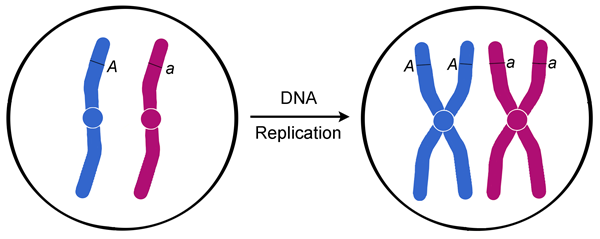
After M phase (discussed below), the daughter cells each begin a new cycle by proceeding to interphase. Each stage of interphase has a distinct set of specialized biochemical processes that prepares the cell for initiation of cell division (see figure below).

G1 phase
Interphase begins with G1 (G stands for gap) phase. During this phase, the cell makes a variety of proteins that are needed for DNA replication.
S phase
During S phase, which follows G1 phase, all of the chromosomes are replicated. Following replication, each chromosome now consists of two sister chromatids (see figure below). Thus, the amount of DNA in the cell has effectively doubled, even though the ploidy, or chromosome count, of the cell remains at 2n. Note: Chromosomes double their number of chromatids post replication but the nuclei remains diploid as the number of centromeres and chromosomes remains unchanged. Hence, the number of chromosomes in the nucleus, which determines the ploidy, remains unchanged from the beginning to the end of the S phase.

G2 phase
Following S phase, the cell enters G2 phase. During G2, the cell synthesizes a variety of proteins. Of particular significance to the cell cycle, most microtubules – proteins that are required during mitosis – are produced during G2.
G0 phase
Not all cells are continually replicated. Non-replicating cells are found in a stage of the cell cycle called G0. These cells may be quiescent (dormant) or senescent (aging or deteriorating). Such cells generally enter the G0 phase from G1. Cells may remain quiescent in G0 for an indeterminate period of time (when no more new cells are needed), only to re-enter G1 phase and begin dividing again under specific conditions. While quiescent cells may re-enter the cell cycle, senescent cells do not. One reason that cells trigger senescence is to ensure that damaged or defective DNA sequences is not passed on to daughter cells.
Checkpoints
Cell cycle progression requires a sequence of processes, with later events dependent on the completion of earlier ones. This dependency ensures that each cell division accurately replicates the genome and transmits it to daughter cells. Checkpoints control the cell’s progress through the cell cycle, and ensure that key processes such as DNA replication and DNA damage repair are completed before the cell cycle is allowed to progress into the next stage. Checkpoints also ensure that both daughter cells receive the same number of chromosomes and that daughter cells are genetically identical to the parents.